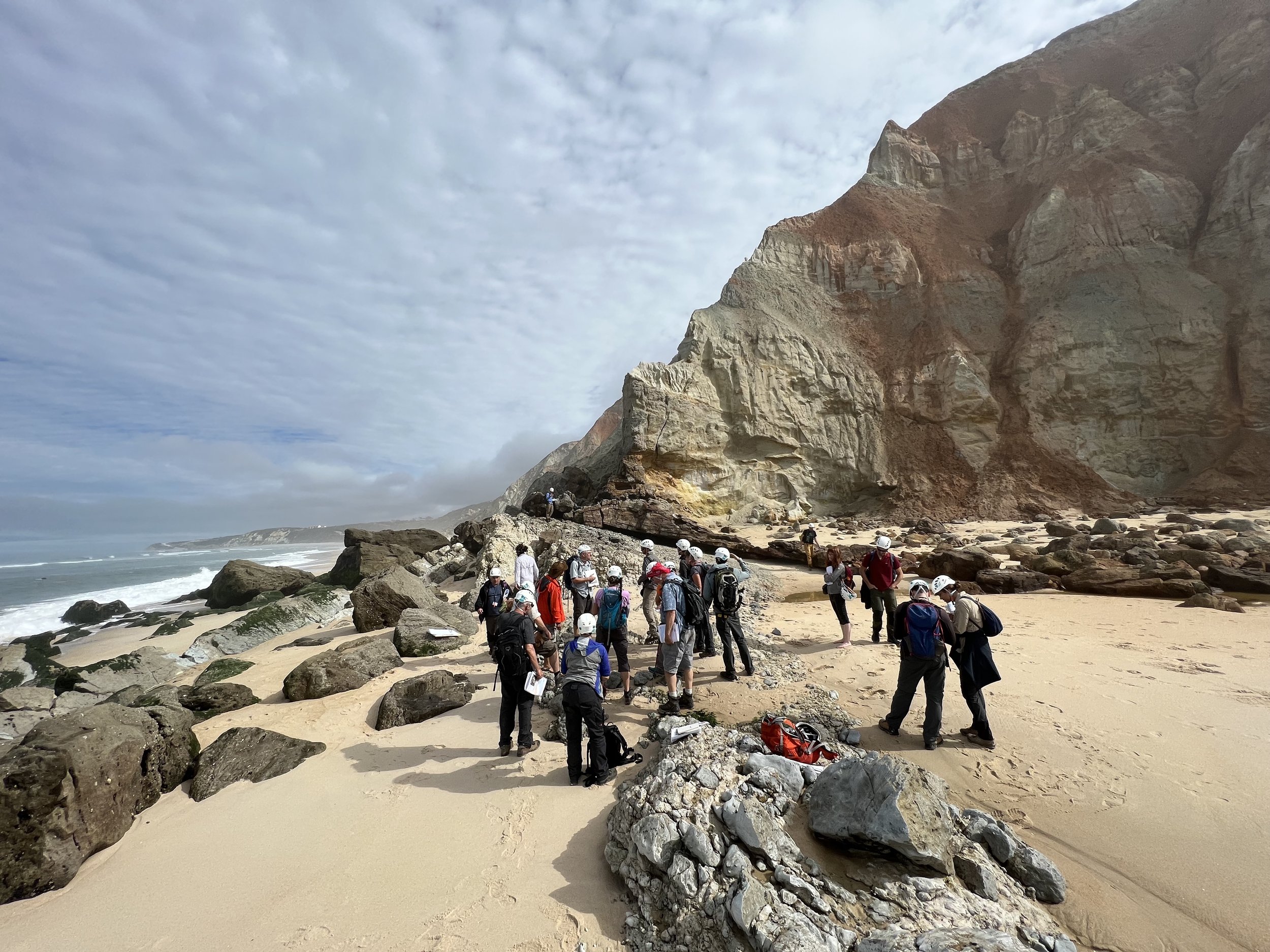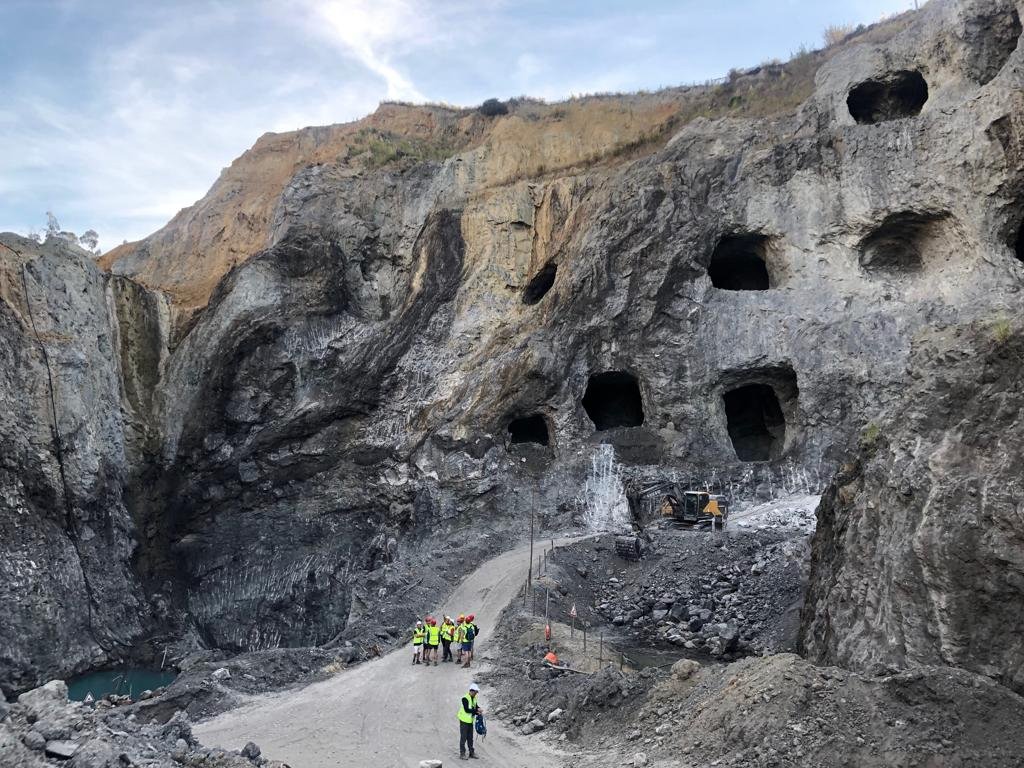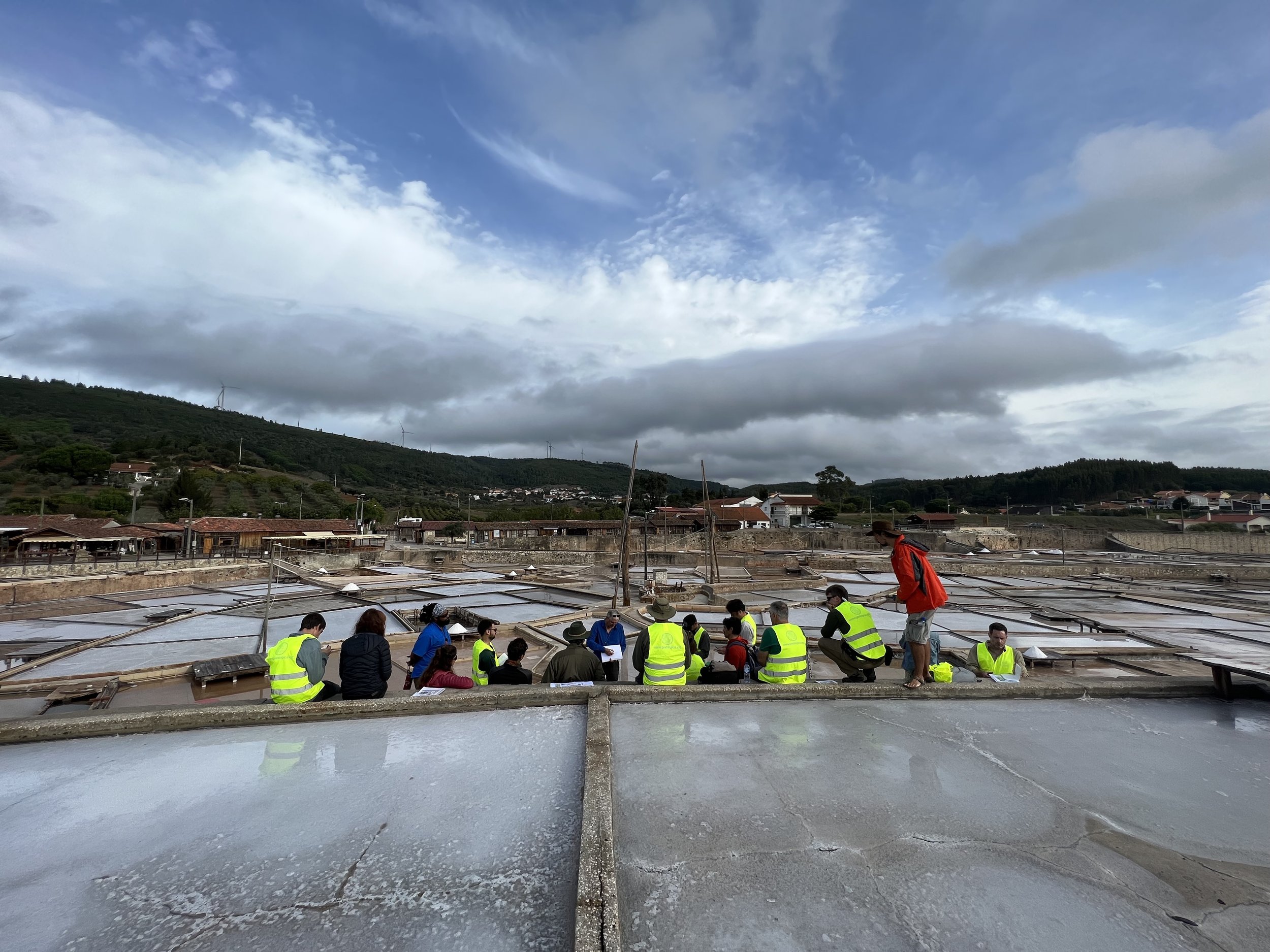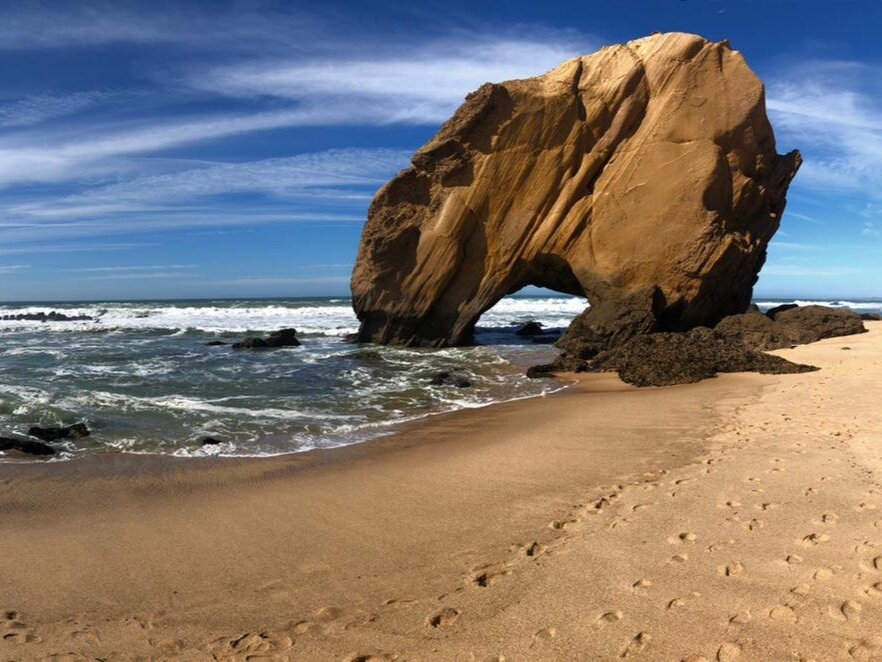SALT Tectonics Course in POrtugal - Extended Edition
Emphasis on the implications for seismic imaging and geological risks associated with drilling.
(May, 10-17th 2025)
Introduction
This 8 day field course is an extended version of the already world famous Geo Logica Salt Basins TIG field trip.
The course focuses on the main aspects of salt tectonics, particularly on diapirs and their interplay with sedimentary processes and igneous processes. Focus will be given to the implications on seismic imaging and geological risks associated with drilling salt structures. Participants will observe structural, sedimentary and igneous features that are usually not detectable on seismic data.
The onshore Algarve and Lusitanian basins located on the Atlantic West Iberian Margin present world-class exposures that are ideal to visualize common aspects and problems that professionals deal with during exploration, appraisal, and development phases of hydrocarbon accumulations and for underground energy storage (natural gas, hydrogen, compressed air, battery systems, etc…), CCUS, geothermal energy and toxic /nuclear waste storage.
The geological structures in the two basins improve our understanding of the origin and complexity of evaporitic sequences and related halokinetic processes, limitations with imaging and interpreting internal and external structure of salt diapirs. Participants will observe the implications of salt tectonics for reservoir properties and trapping mechanisms on upturned salt diapir flanks, thermal gradient variation and intra-salt heterogeneity.
This field trip is based on research undertaken by the instructors over the past 9 years in two Portuguese basins. Participants will understand salt tectonics concepts while observing world class field examples, which include:
An unique chance to see outcrops with an oil field trapped against a salt diapir;
Visit a salt mine inside a squeezed diapir beneath the centre of Loulé City in Algarve;
Explore the deepest evaporite quarry in Portugal, which was originally a mine;
Multiple exceptional outcrops of salt-related structures in Central and southern Portugal.
Internal Structure of Caldas da Rainha Diapir at Sogerela gypsum quarry showing the original mine galleries.
Rio Maior “Salinas” salt extraction plant.
Course Characteristics
Physical requirements: Easy to moderate. Participants will be required to walk a maximum of 2 km at some localities over easy relatively flat terrain. Not recommended for claustrophobic individuals (visit to mine).
Duration: 8 days
Type: Fieldwork, summary sessions and evening talks
Area: Central Costal Portugal and Central Algarve
Target audience: Salt Specialists, Structural Geologists, Petroleum Geologists, Geophysicists, Mining Geologists and Engineers.
Pre-requisites: Structural geology and salt tectonic principles
What’s included: Transportation, meals, accommodation in 4 star (5 nights) and 5 Star (3 nights) hotels, digital and paper field guide, personal insurance, PPE bag (hard hat, reflective vest, emergency blanket, waterproof whistle) and walking poles (at request).
Number of participants: Minimum of 10 and maximum 14 persons + 3 guides / instructors.
Course Cost: 6000 € (excl. tax). Special discount rates available for EFG - European Federation of Geologists (20%) or APG - Associação Portuguesa de Geólogos members (10%). Groups discounts available upon request.
Exhumed oil field trapped against a salt diapir at Azeche Asphalt Mine at Praia Paredes de Vitória.
Upper Jurassic units at Northern flank of Santa Cruz diapir.
Instructors
Pedro Barreto: Founder of Geo Logica, graduated in Geology from University of Lisbon and MSc in Tectonics, Royal Holloway, University of London. Former Senior Structural Geologist at CGG NPA Satellite Mapping and Senior New Ventures & Exploration Geologist at Partex O&G where he was Lead Project Geologist for Portuguese exploration. Expert in structural geology from rifting to compressional settings with research and fieldwork in Portugal, Africa, Middle East and South America. Co-author of several publications and presentations on rifting and salt tectonics and implications on exploration, development and exploitation of natural resources for energy production and storage.
Ricardo Pereira: Assistant Researcher at GeoBioTec (Univ. Nova Lisboa) and Researcher/External collaborator at Instituto Dom Luiz (Univ. Lisboa). Graduated in Geology from Lisbon University, MSc in Stratigraphy and Sedimentology at Lisbon University and PhD from Cardiff University, developing research on the evolution of passive continental margins, salt tectonics and subsurface energy storage. With over 22 years experience in the O&G industry, Ricardo has worked as regional exploration geologist for PARTEX Oil and Gas, and Petroleum Development Oman, contributing to world class discoveries in major salt provinces, including the discovery of pre-salt Santos Basin, the Oman salt provinces and offshore Angola.
Pure white coarse-grained halite shear zones rich in CO2 with elliptical blow-out hole in roof of the mine gallery caused by overpressured gas at Loulé mine.
Boudinaged ultrabasic lamprophyre dyke with ‘jigsaw’ breccia texture and halite filling veins at Loulé mine.
MAIN TOPICS COVERED ON FIELD TRIP
Timing of diapirism and its relation with tectonic events;
Salt diapirism and interaction with sediments: differences and similarities between carbonate and clastic overburden interactions;
Salt diapirism and interaction with igneous rocks.
Internal structure of diapirs (layered evaporites, volcanic intrusions, interbedded carbonate and clastic sediments, folding, boudinage, faulting and shear zone development in evaporites);
Fault and salt welds and fluid flow along weld;
Unconformities: J-hook, flap-onlap, low-angle wedge;
Cap rock formation and dissolution breccias around salt structures;
Hydrocarbon trap geometries against salt diapirs;
Structural inheritance and onset of halokinesis;
Salt-sediment interface controlling fluid flow;
Fluid flow through salt;
Reworked breccias from diapiric material and roof sediments;
Roof collapse and sedimentary infill above diapirs;
Reservoir damage around salt diapirs;
Implications of field work observations for seismic imaging of salt diapirs and seismic interpretation of salt structures.
Potential drilling hazards prediction and mitigation.
Field Trip Program
Day 1
-
Departure from Lisbon Airport (12:00 am)
DrIve to Alcobaça
Hotel (Alcobaça )
Field course briefing meeting (Hotel)
Dinner at Alcobaça
-
On the first day the group will drive to an hotel in Alcobaça where a field course briefing meeting will take place.
This will include an HSE Briefing, geological setting and general concepts on salt tectonics.
Intra-diapir shale, marls and sandstone stringers at Loulé mine
Aerial view of water well and ancient man-made salt flats at Salinas de Rio Maior.
Syn-halokinetic slumps at Praia da Concha, São Pedro de Moel Diapir
Day 2
-
Depart from Alcobaça
Óbidos Castle outcrops
Lunch at Óbidos
Sogerela mine
Sobral da Lagoa quarry
Hotel at Alcobaça
Summary meeting
Dinner at Alcobaça
-
On this day the group will examine the eastern and western flanks of the Caldas da Rainha-Óbidos Diapir and the structures within the salt sequence, the Dagorda evaporite sequence.
The internal diapir structures will be observed at the Óbidos Castle and the SOGERELA Quarry. At the castle sub-vertical intra-salt Hettangian limestone stringers are folded to the horizontal, possibly representing a change in the diapir flow from a vertical neck to a glacier. At the quarry, located in the centre of the diapir, shales, dolomitic shales and evaporites (mainly gypsum but also halite at depth) are tightly folded with steeply-plunging curtain fold axes in most of the quarry.
On the western flank of the diapir, at Sobral da Lagoa, the upturned Upper Jurassic carbonate section presents bedding dips that fan from steeply dipping to gently dipping, away from the diapir. Three unconformities are present in this section and a reworked carbonate breccia, interpreted to be from the diapir lid, is visible in the steeply-dipping units near the diapir contact.
Óbidos Castle sits on a large limestone stringer in Caldas da Rainha Diapir.
Sub-vertical curtain folds in gypsum beds within Caldas da Rainha Diapir at Sogerela Quarry.
Day 3
-
Depart to Praia Paredes de Vitória
Azeche Mine Section
Sra. Da Vitória Headland Section
Lunch at Praia Paredes de Vitória
Praia das Pedras Negras section
Praia das Conchas section
Nazaré headland
Hotel at Alcobaça
Thermal SPA
Evening presentation
Dinner at Hotel
-
On the third day participants will inspect the São Pedro de Moel Diapir. This includes observing a superb example of an exhumed paleo oil field (Azeche Mine and Pedra Negras) trapped in upturned Cretaceous sandstones and sealed against a sub-vertical salt diapir wall, where a J-Hook unconformity can be observed.
Also includes exposures of a topographic depression associated with salt dissolution at Senhora da Vitória headland, where Neogene sediments were depositing on top of a collapsed salt rooftop. Additionally, slumped and folded lower Jurassic carbonates adjacent to the eastern flank will be observed at Praia da Concha.
J-hook unconformity in Cenomanian limestone conglomerates associated with Mina de Azeche exhumed oil field at Praia de Paredes de Vitoria.
Oil impregnated folded dolomitic black shales within an abandoned quarry at São Pedro de Moel Diapir, Praia das Pedras Negras.
Nazaré Fault affecting Upper Jurassic sequence at Nazaré Promontory,
Day 4
-
Depart to Santa Cruz
Santa Cruz Northern section
Lunch at Praia da Física
Santa Cruz Southern section (Praia do Guincho to Praia Formosa)
São Martinho do Porto headland section
Evening presentation
Dinner at Alcobaça
Hotel at Alcobaça
-
On this day participants will work along a coastal section crossing the Santa Cruz Diapir. This includes the observation of both internal composition, structure, and deformation of the diapir (folding and faulting), as well as the external structuring of the adjacent sedimentary sequences.
The diapir flanks present features such as granulation seams, faults, and natural hydrocarbon accumulations, as well as different types of halokinetic unconformities (J-hook and ‘flap-onlap unconformity’).
The day will end at the western flank of Caldas da Rainha-Óbidos Diapir in São Martinho do Porto, where it is possible to observe several halokinetic sequences in the Upper Jurassic sequence. Here, the fossiliferous limestones and sandstones near the diapir contact are steeply dipping and fan away into gently dipping red sandstones and grey marls, where it is possible to identity 5 five angular unconformities, that limit 6 Halokinetic Sequences
Penedo do Guincho submarine canyon cutting diapir flank, Santa Cruz.
Halokinetic Sequences at western flank of Caldas da Rainha-Óbidos diapir at São Martinho do Porto.
Western limit of Caldas da Rainha-Óbidos Diapir at São Martinho do Porto.
Day 5
-
Depart to Rio Maior
Salinas de Rio Maior
Portela da Teira Sill
Alcobertas Fault weld along Rio Maior - Porto de Mós diapir
Lunch at Serra dos Candeeiros
Drive to Santiago do Cacém
CAMP and base salt Dolomites at outcrops at Aldeia de Chãos
Drive to Albufeira
Hotel at Albufeira
-
On the fifth day participants will visit the man-made Salinas de Rio Maior (salt flats). Here, where the salt body reaches a maximum width of 1 km, the brine extracted from an ancient well is left to evaporate on shallow man-made limestone-floored salt flats.
Afterwards the team will observe with the fault welding along the NNE–SSW trending Rio Maior-Porto de Mós salt wall that extends for around 15 km N-S.
On the eastern flank Kimmeridgian–Tithonian clastics and volcanic sills are exposed in the zone near the TECNOVIA Quarry and, further north, there is a major fault welding zone with a large component of sinistral strike-slip deformation along the salt wall, as well as down-to-the-east extension.
During lunch it will be possible to observe the western flank of the diapir wall which consists of a 4 km-wide, gently upturned, zone of Candeeiros Formation limestones of Middle Jurassic age.
After lunch the group will drive to Santiago do Cacém to observe pre-salt sequence, the base of the Dagorda evaporite sequence with “platty dolomites” (finely laminated dolomites intercalated with gypsum) with intercalated CAMP (volcanic).
After visiting this outcrop at Aldeia de Chãos, the team will drive to Albufeira where will be staying at an hotel near the sea and adjacent to the Albufeira Diapir.
Ancient man-made salt flats at Salinas de Rio Maior. Valley in the background follows fault welding along the NNE–SSW trending Rio Maior-Porto de Mós salt wall that extends for around 15 km.
Berriasian Portela da Teira Sill on the eastern flank of Rio Maior Diapir.
Base of Dagorda Fm. dolomites intercalated with CAMP Volcanism at Aldeia de Chãos, Santiago do Cacém.
Day 6
-
Drive to Loulé
Visit Tech Salt Mine
Lunch at Loulé
Drive to Hotel
Summary meeting at Hotel
Dinner at Albufeira
Hotel at Albufeira
-
On the sixth day the group will drive to Loulé to visit the Tech Salt Mine within Loulé Diapir. Here, participants will examine the internal composition of a salt diapir, the different types of evaporites, shale, marls and sandstone stringers, understand the formation of folding and boudinage styles and patterns, identify brittle faulting, shear zones and igneous dykes, and observe gas blowout structures.
In the afternoon the group will gather at the hotel to discuss intra-salt structures on seismic and well data and compare these with the structures observed during the morning at the Loulé Salt Mine.
Intra salt clastic stringer at Loulé salt Mine
Brittle fault with red clay fragments in halite at Loulé mine.
Day 7
-
Drive to Loulé
Visit Tech Salt Mine
Lunch at Loulé
Outcrop at Praia da Baleeira
Dinner at Albufeira
Hotel at Albufeira
-
On the seventh day the group will return to Loulé Salt mine, to discuss origin of geo technical issues than can arise during the drilling and development stage of production wells drilled through salt structures, as discussed during the previous day summary meeting.
After lunch at Loulé, the team will drive back to Albufeira to observe the Marina de Albufeira section at Praia da Baleeira where cap rock formation processes and overturned flaps geometries will be discussed.
Intra-salt fractures infilled with bittern salts at Loulé Salt Mine.
Overturned Albufeira Diapir flank at Praia da Baleeira, Albufeira
Day 8
-
Walk to Praia dos Arrifes
Coastal section at Praia dos Arrifes
Drive to Lisbon
Hotel in Lisbon
-
On the last day of the field course the group will walk along the coastal area of Praia dos Arrifes, where it is possible to observe the Southern flank of Albufeira Diapir outcropping with near vertical lower Cretaceous strata truncated by an angular unconformity onlapped by Miocene strata.
After lunch at Praia dos Arrifes, the group will drive back to Lisbon where the field course will end with a wrap up dinner overlooking the city.
Near vertical lower Cretaceous strata truncated by an angular unconformity onlapped by Miocene strata on the southern flank of Albufeira Diapir at Praia dos Arrifes, Albufeira.
References
Davison, I., Barreto, P. & Andrade, A.J.M. (2016). Loulé, the anatomy of a squeezed diapir, Algarve Basin, southern Portugal. Journal of the Geological Society, London, 174, 41–55.
Davison, I., & Barreto, P., 2019. Exhumed Portuguese oil field suggests conjugate potential. GEOExPro, volume 16, no.3 pp. 38-40.
Davison I & Barreto, P. 2019. Salt tectonics and hydrocarbon accumulations trapped on diapir flanks in the Lusitanian Basin, Portugal. Salt Tectonics, Associated Processes, and Exploration Potential: Revisited 1989-2019. GCSSEPM Annual Perkins Rosen Research Conference, Salt Tectonics, electronic files only, p. 300-313.
Davison, I., & Barreto, P., 2020. Deformation and sedimentation processes, and hydrocarbon accumulations on upturned salt diapir flanks in the Lusitanian Basin, Portugal. Petroleum Geoscience, DOI: https://doi.org/10.1144/petgeo2019-138
Barreto, P., 2024. Understanding the riddles of energy and CO2 geostorage in and around salt structures from field examples in Portugal. Salt Tectonics in the Energy Transition Conference 23-24 September 2024. Geological Society of London (Oral presentation).


























